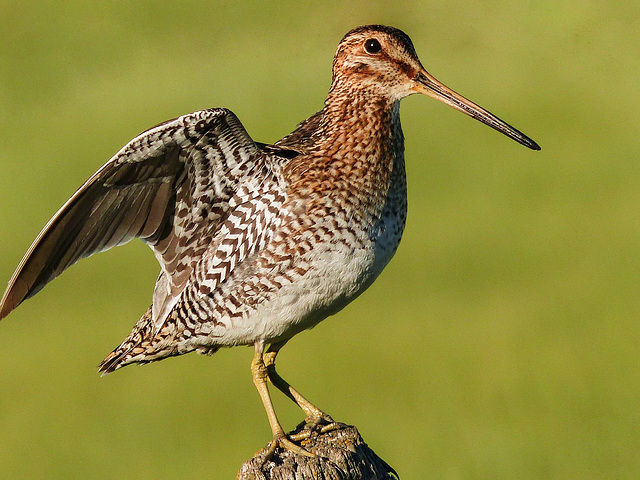I like the post as much as the bird
A favourite bird to photograph
Reaching those faraway feathers
The one-legged stance
The poser - Wilson's Snipe
Standing in sunshine
Wilson's Snipe
Wilson's Snipe / Gallinago delicata
Balancing act
Wilson's Snipe
Wilson's Snipe
Wilson's Snipe - from the archives
Wilson's Snipe / Gallinago delicata
Wilson's Snipe / Gallinago delicata
Wilson's Snipe
Wilson's Snipe, having a stretch
Wilson's Snipe
Couldn't have chosen a better perch myself : )
Wilson's Snipe hiding in the grass
Time to preen
Wilson's Snipe, seen from afar
This Snipe 'doesn't have a leg to stand on'
One of my favourite birds to photograph
One of my favourites to photograph
The highlight of my day
The Wilson's Snipe - such a fine bird
Two of a kind!
Wilson's Snipe - what a beauty
A Snipe from last year
Great choice of fence post
A two-legged Wilson's Snipe : )
Wilson's Snipe
Purple grasses bokeh
Beautiful evening light
In the early evening light
I love Snipes
Lichens and all
Wilson's Snipe
In the rain and hail
Wilson's Snipe
Wilson's Snipe
Wilson's Snipe
He who likes the rain
See also...
Keywords
Authorizations, license
-
Visible by: Everyone -
All rights reserved
-
125 visits
Just a little stretch


This photo was taken on 15 June 2016, when I went for a short drive SW of the city. I really do need to go to a few different areas, to see different bird species, but my most recent drives have been mainly to check on three different pairs of Mountain Bluebirds, and to see at least one of the usual Wilson's Snipes. This one gave a little stretch. On this trip, I saw all the usual things, knowing that before too long, all of them will have left on their long, long journeys.
"These plump, long-billed birds are among the most widespread shorebirds in North America. They can be tough to see thanks to their cryptic brown and buff coloration and secretive nature. But in summer they often stand on fence posts or take to the sky with a fast, zigzagging flight and an unusual “winnowing” sound made with the tail." From AllAboutBirds.
www.allaboutbirds.org/guide/wilsons_snipe/id
"Wilson's Snipe (Gallinago delicata) is a small, stocky shorebird. This species was considered to be a subspecies of the Common Snipe (G. gallinago) until 2003 when it was given its own species status. Wilson's Snipe differs from the latter species in having a narrower white trailing edge to the wings, and eight pairs of tail feathers instead of the typical seven of the Common Snipe. Its common name commemorates the American ornithologist Alexander Wilson." From Wikipedia.
en.wikipedia.org/wiki/Wilson's_snipe
According to Fisher and Acorn's book, "Birds of Alberta", "the common Snipe is both secretive and well camouflaged, so few people notice it until it flushes suddenly from a nearby grassy tussock. As soon as the Snipe takes to the air, it performs a series of quick zigzags - an evasive maneuver designed to confuse predators. Because of this habit, Snipes were among the most difficult birds to shoot (in the days when shorebirds were hunted for sport), and skilled sportsmen were known as "snipers" - a term later adopted by the military."
youtu.be/Z16CUdX2g5Q
"These plump, long-billed birds are among the most widespread shorebirds in North America. They can be tough to see thanks to their cryptic brown and buff coloration and secretive nature. But in summer they often stand on fence posts or take to the sky with a fast, zigzagging flight and an unusual “winnowing” sound made with the tail." From AllAboutBirds.
www.allaboutbirds.org/guide/wilsons_snipe/id
"Wilson's Snipe (Gallinago delicata) is a small, stocky shorebird. This species was considered to be a subspecies of the Common Snipe (G. gallinago) until 2003 when it was given its own species status. Wilson's Snipe differs from the latter species in having a narrower white trailing edge to the wings, and eight pairs of tail feathers instead of the typical seven of the Common Snipe. Its common name commemorates the American ornithologist Alexander Wilson." From Wikipedia.
en.wikipedia.org/wiki/Wilson's_snipe
According to Fisher and Acorn's book, "Birds of Alberta", "the common Snipe is both secretive and well camouflaged, so few people notice it until it flushes suddenly from a nearby grassy tussock. As soon as the Snipe takes to the air, it performs a series of quick zigzags - an evasive maneuver designed to confuse predators. Because of this habit, Snipes were among the most difficult birds to shoot (in the days when shorebirds were hunted for sport), and skilled sportsmen were known as "snipers" - a term later adopted by the military."
youtu.be/Z16CUdX2g5Q
- Keyboard shortcuts:
Jump to top
RSS feed- Latest comments - Subscribe to the comment feeds of this photo
- ipernity © 2007-2024
- Help & Contact
|
Club news
|
About ipernity
|
History |
ipernity Club & Prices |
Guide of good conduct
Donate | Group guidelines | Privacy policy | Terms of use | Statutes | In memoria -
Facebook
Twitter

Sign-in to write a comment.